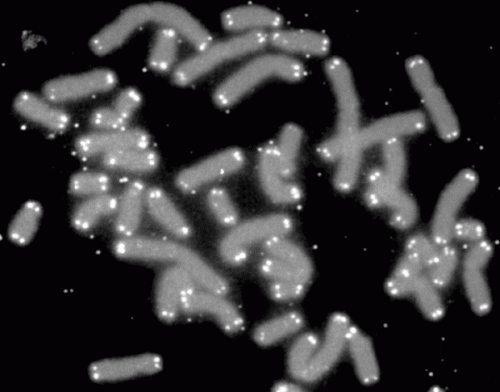Telomere length varies across human tissue types

Telomere length has long been considered an important biomarker in human aging and disease, but most studies on the relationship between telomere length and health have looked only in a single tissue type: blood. This limitation has raised the question of whether blood cells are a reliable proxy for other tissues for researchers studying the effects of aging, disease and lifestyle factors on telomere length.
A new study, published in the September 11 issue of Science, answers this question by examining telomere length in over 20 different human tissue types, from nearly 1,000 individual post-mortem donors. The results show that telomere length in whole blood can serve as a stand-in for telomere length in most other tissues, and further bolsters existing research on the relationship between telomere length, ancestry and aging.
Telomeres are repetitive, non-coding sequences of DNA found at the ends of chromosomes, acting like protective caps to prevent deterioration of the genome. Each time a cell divides, the chromosomes have to be replicated, giving each new cell a new copy. The enzymes that do this can't quite reach the end of the chromosome, so a little bit of the tip is lost in every duplication. Telomeres provide a small amount of extra chromosome as a buffer, protecting important genetic information from being lost.
Normal aging is associated with telomere shortening, and telomere shortening has been linked to mortality and age-related diseases. But the relationship between telomere shortening, aging and disease is not completely clear—partly because scientists don't fully understand the ways in which telomeres vary between different tissue types.
"Most studies on human telomere length focus on tissue types that are easy to collect from living subjects, like whole blood or saliva," said first author Kathryn Demanelis, Ph.D., a postdoctoral scholar in the Department of Public Health Sciences at the University of Chicago. "We wanted to see how well the length of telomeres found in whole blood cells aligned with those found in other tissues."
In the study, the scientists took advantage of the Genotype-Tissue Expression (GTEx) project, a massive public resource focused on collecting samples from many different tissues from hundreds of human subjects.
"The GTEx study was originally designed to study how inherited genetic variation regulates gene activity in different tissues, and how tissues differ from one another," said senior author Brandon Pierce, Ph.D., Associate Professor of Public Health Sciences and Human Genetics at UChicago. "We saw the GTEx tissue bank as an opportunity to access tissue types that we normally can't study easily, and to look at an important biomarker—telomere length—and start to ask deeper questions about the relationship between telomere length and diseases like lung cancer, and how telomeres shorten with age in different kinds of tissue."
The researchers used a new type of assay for measuring telomere length, comparable in cost to traditional methods but with "higher throughput and better precision," according to study co-author Muhammad Kibriya, MD, Ph.D., Research Associate Professor at the Institute for Population and Precision Health at UChicago. By analyzing more than 6,000 tissue samples across over 20 tissue types and nearly 1,000 unique post-mortem human subjects, Kibriya said, "We were able to find statistically significant tissue-to-tissue differences in telomere length within the sample set."
This allowed the investigators to compare telomere length in a variety of tissues, such as skin, brain, lung, colon and kidney, to measurements of telomere length in blood cells.
They found that out of the 23 tissues they studied, telomere length in 15 tissues showed a clear, positive correlation with telomere length in whole blood cells, supporting the use of easily collected whole blood cell telomere length as a proxy for telomere length in harder-to-access tissues, like brain and kidney.
"We were also able to look across all of these tissue types to answer questions that have been looked at repeatedly for blood cell telomeres," said Pierce. "Some patterns held up across different tissues, like shorter telomeres in aging, and longer telomeres in people of African ancestry, but others didn't, like longer telomeres in females. We observed shorter telomeres among smokers in only a few tissues."
This helps to clarify conflicting results from past studies indicating relationships between individual traits and telomere length, or a lack thereof.
These results will help the researchers understand what aspects of telomere length are consistently due to genetic inheritance versus those that may be affected by lifestyle, environmental exposures or epigenetic changes during a person's lifetime. This in turn will make it easier for scientists to study and understand the roles of specific biomarkers in aging and disease.
"As epidemiologists, we're often trying to answer questions by studying blood samples, so we have to be aware of how these biomarkers might vary across different tissue types," Pierce said. "It's a big limitation. But we know that the inherited genome sequence is the same in every tissue, so if we can understand how certain genetic variations affect biomarkers, like telomere length, in specific tissue types, that makes it easier to study those biomarkers in human populations. We can use inherited genetic variation to predict tissue-specific biomarkers."
Future projects will further explore the GTEx samples to look at various biomarkers across different tissue types. "This first study provides a resource to better understand what telomere length looks like in various tissues and will allow other researchers to compare their data against our results," Demanelis said. "In the future, we'll be looking at other markers like DNA methylation and somatic mutations in different types of tissues to try and understand their relationship to telomere length and aging."
More information: K. Demanelis el al., "Determinants of telomere length across human tissues," Science (2020). science.sciencemag.org/cgi/doi … 1126/science.aaz6876





















